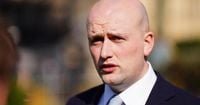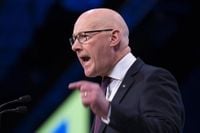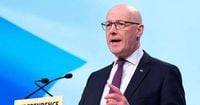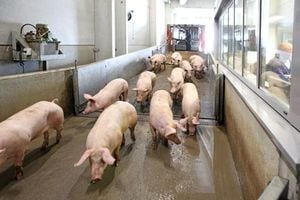John Swinney, Scotland’s First Minister and leader of the Scottish National Party (SNP), has thrown down the gauntlet ahead of the 2026 Holyrood election, staking both his leadership and the party’s future on a renewed push for Scottish independence. On October 11, 2025, at the SNP’s annual conference in Aberdeen, party members voted decisively to back Swinney’s plan: if the SNP wins a majority of seats in the next Scottish Parliament election, they will declare a mandate to pursue a second independence referendum—commonly referred to as IndyRef2.
This bold strategy, which Swinney described as “the most realistic” path forward, echoes the precedent set in 2011. Back then, the SNP’s majority led to negotiations with the UK government and, eventually, the 2014 independence referendum. “The precedent is clear, when the SNP win a majority, we deliver a referendum on independence. We did it in 2011 and I want us to do it in 2026 to give our people a choice on their future,” Swinney told delegates, according to BBC. He was met with enthusiastic support from party members, including deputy leader Kate Forbes, who voted in favor of the plan.
But Swinney’s approach is not without controversy—even within his own party. Some grassroots activists and former MPs argued for treating the 2026 election itself as a de-facto referendum, a move that would have allowed a mandate for independence if pro-independence parties collectively secured more than 50% of the vote. Derek Pretswell, an SNP member from Oban and Lorn, described this as a “fair mechanism” to demonstrate majority support for independence without needing the UK government’s blessing. However, Swinney pushed back, insisting he did not take up leadership “to make a difference at the margins.” Instead, he declared, “I took the leadership to deliver independence and that’s exactly what I’m going to do for Scotland. We will deliver Scotland’s choice and we, the Scottish National Party, will win independence for Scotland.”
The conference saw two key amendments—one to treat the 2026 election as a substitute referendum and another requiring the SNP to win 50% of votes on the regional list—voted down. However, the party did accept other amendments, including a pledge to support Scotland joining the European Union if independence is achieved and to work constructively with other parties.
Deputy leader Keith Brown did not mince words when describing Swinney’s resolve. “I’ve never seen a move as brave as that—he’s putting everything on it,” Brown told reporters, as quoted by The National. “Nothing worth achieving is ever going to be easy. But he’s also taken that kind of stance and I commend him for it.”
Swinney, for his part, predicted that the SNP would “win big” at the 2026 election. “We’re not just going to win, we are going to win big. We’re going to win a majority for the SNP to deliver that choice for Scotland,” he declared, urging members to present a clear and unambiguous message to voters: “Only a vote for the SNP will secure Scotland’s right to decide. Only a vote for the SNP will secure Scotland’s independence and that is what this party is about.”
Yet, the road ahead is anything but smooth. The UK government’s consent is still required for a legally recognized referendum, and Labour leader Sir Keir Starmer has made his position clear. “I could not imagine indyref2 taking place during my time as prime minister,” Starmer said in June 2025, according to the BBC. This stance means that, even if the SNP achieves a majority, Westminster could block another referendum—an outcome that has frustrated many in the independence movement.
In response, Swinney hinted at secret tactics ready to be deployed should Westminster refuse consent. “Nobody knows the tactics I’m going to deploy if we get 65 seats in the next election,” he teased at the conference, as reported by The Herald. Swinney’s comments have sparked speculation about what alternative strategies the SNP might pursue, though he remains tight-lipped for now.
The debate over strategy has exposed divisions within the broader independence movement. Some, like veteran SNP activist Graeme McCormick, have criticized Swinney’s plan as a “donkey,” pointing to declining party membership and suggesting that the party is “hollowing out.” Alba leader Kenny MacAskill, a former SNP minister, went further, calling the vote a “missed opportunity” and accusing Swinney of handing Westminster a veto. “This vote is a missed opportunity to unite the independence movement and pursue a clear, credible and popular strategy to seek and achieve a mandate for independence,” MacAskill said.
Opposition parties, meanwhile, seized on the internal disagreements. Rachel Hamilton, deputy leader of the Scottish Conservatives, was blunt: “The SNP showed themselves in their true colours at this debate, ludicrously labelling the same old obsession with independence ‘a fresh start’,” she said. Hamilton went on to argue that the party had “lost all credibility with their renewed drive for an unwanted referendum.”
Scottish Labour’s constitution spokesman Neil Bibby was equally scathing. “One person dies from a drug overdose almost every seven hours in Scotland, one in six Scots is on an NHS waiting list, violence is rising in our schools, and a housing emergency is causing misery for families across the country—yet the SNP has no answers,” he said, as reported by BBC and The National. Bibby accused the SNP of “wasting their time fighting among themselves over the constitution rather than focus on fixing Scotland’s public services.” He argued that the 2026 election offers a chance to “remove the SNP from power and elect a Scottish Labour government that will end the chaos and take Scotland in a new direction.”
Stephen Flynn, the SNP’s leader at Westminster, sought to turn the tables on Labour, describing them as a party with “power but no purpose.” He told the conference, “Through their actions, they have already shown Scotland what a Labour victory at the Holyrood election next year would look like. Our nation must set its sights so much higher than that. Scotland must aspire for something so much better and friends, only the SNP can deliver that future.”
Despite the heated debate, one thing is clear: the SNP is now united behind Swinney’s strategy, at least for the time being. The party will spend the months leading up to May 2026 advancing the case for independence, seeking to convince voters that only independence can bring the “fresh start” Scotland needs. The stakes could hardly be higher. With opposition parties highlighting crises in public services and the UK government standing firm, the SNP faces a daunting political challenge. But, as Swinney and his allies see it, that challenge is worth every risk.
The outcome of the 2026 Holyrood election will not only determine the future of the SNP and John Swinney’s leadership—it could shape the very future of Scotland itself.






